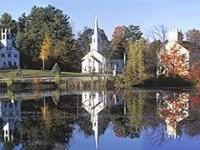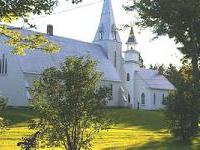 We’ll catch up with the Gustins, Macks and Millers near the U.S.-Canada border later. For now, their nephew Daniel Way, born in 1794, is growing up in Marlow, Cheshire County, NH. The town has voted six months’ schooling for all children in 1792 and since then several district schools have been built. The 19 th century begins and young Daniel is probably attending school and also learning by observing his elders. As the saying goes, "It takes a village to raise a child."
We’ll catch up with the Gustins, Macks and Millers near the U.S.-Canada border later. For now, their nephew Daniel Way, born in 1794, is growing up in Marlow, Cheshire County, NH. The town has voted six months’ schooling for all children in 1792 and since then several district schools have been built. The 19 th century begins and young Daniel is probably attending school and also learning by observing his elders. As the saying goes, "It takes a village to raise a child."
Daniel is growing up in Post-Revolutionary War America. The Second Great Awakening, a period of intense religious revival, is turning New Hampshire into a hotbed for the rapid growth of several denominations ferociously competing with each other for followers. Methodists, Baptists, Freewill Baptists, Pedobaptists and Universalists are fighting it out. The people are familiar not only with the Bible but also with controversial religious teachings cited by their preachers. Swedenborg (or Sweedenburg), a mystic Swedish theologian (1688-1772) has put in writing his divine revelations. His books, like "Heaven and Hell," are inspiring many, among them Joseph Smith who will establish in the 1830s the Church of Jesus-Christ of Latter-Day Saints (Mormons). Smith’s mother Lucy is a daughter of Solomon Mack, an early settler of Marlow to whom Daniel is related through his aunt Ethelinda Way. She is married to Silas Mack Jnr whose grand-father Ebenezer was a cousin of Solomon and Marlow’s Pedobaptist preacher.
 The people of Marlow fight and argue over which of their beliefs, some quite unorthodox, should rule the day. Although a Baptist society is formed by 1777 it is not until 1792 that a first meeting-house is built on Marlow Hill. Having quickly fallen into disuse, it is replaced only in 1829, this delay being caused in part by violent disagreements among different Baptists groups, notably about which faith any resident preaching Minister should ascribe to. Daniel and his family live on road 18 on Marlow Hill, not far from the Baptist Church. Are Daniel’s parents Baptist? Will Daniel become for a while a Universalist like his uncle Asa Way and some of his Miller and Gustin relatives? All we know for certain is that he will later join the Adventist faith founded in about 1831 by William Miller who predicated that the End of the World would come in October 1843…Daniel Way is a free thinker no doubt, schooled to a degree and, as we will see, fairly well informed about the controversial theological views of the times.
The people of Marlow fight and argue over which of their beliefs, some quite unorthodox, should rule the day. Although a Baptist society is formed by 1777 it is not until 1792 that a first meeting-house is built on Marlow Hill. Having quickly fallen into disuse, it is replaced only in 1829, this delay being caused in part by violent disagreements among different Baptists groups, notably about which faith any resident preaching Minister should ascribe to. Daniel and his family live on road 18 on Marlow Hill, not far from the Baptist Church. Are Daniel’s parents Baptist? Will Daniel become for a while a Universalist like his uncle Asa Way and some of his Miller and Gustin relatives? All we know for certain is that he will later join the Adventist faith founded in about 1831 by William Miller who predicated that the End of the World would come in October 1843…Daniel Way is a free thinker no doubt, schooled to a degree and, as we will see, fairly well informed about the controversial theological views of the times.
In 1812, war breaks out between the United States and Great Britain (including Canada). Daniel is not among Marlow’s twenty odd enlisted soldiers. A Daniel Way did join New York’s militia (Knikerbocker’s 45th Regiment), but he lived and died in Rensselaer, N.Y.. In February 1816, a year almost to the day after peace is ratified Daniel, 22, marries Keziah Jaquith. Her story is next.
By the way, Marlow Methodists eventually won the day and used the Baptist meeting-house built in 1829 on Marlow Hill. Then, in 1845, that church was removed to the lower part of the Village of Marlow ("The Plains"). This upset some followers who then built a second Methodist Church on Marlow Hill. This one was also moved to the Plains and used by Universalists. Today, the two Marlow churches, one initially Baptist (now called Jones Hall) and the other Methodist, stand side by side in Marlow, their lovely architecture reflected in the waters of the town’s pond …not unlike Way’s Mills’ charming churches facing each other by the Niger River, all of them simple yet eloquent symbols of the many religious faiths to which Marlow and Way’s Mills’ residents once belonged.
To be continued...